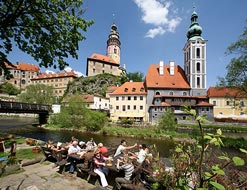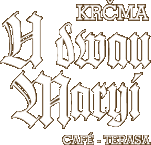
What our predecesors used to eat
The formation of Bohemia also gave rise to traditional Bohemian foods. The basic foods were millet, honey, eggs, legumes, milk, cabbage, mushrooms and fruits. Salt was also widely in use. One of the most important foods of our predecesors was black bread. The chronicler Kosrnas mentioned bread with cheese as the basic meal of working men. He also describes milk, sour milk or buttermilk.
Gruels were the mein stays of old-time Bohemian cuisine: millet, oat, or other cereal gruels or semolina. Peas were typical in good old time Bohemian cuisine. In fact, everything that could be gathered or collected went into the bacic food: various edible roots, mushrooms and wild fruits. A corns were eaten in the time of emergency. Apples, pears and plums were also staples of medieval menu as well. Sour cherries were added later in the time of John of Luxembourg. Fruits, especially baked apples, were served as garnish to all sorts of meat. One of the most common pork dishes was boiled salted pork. Various root- or leaf spices such as sage, nasturtium, pepper; bay-leaf and ginger; were also used. Bay-leaf, ginger and other spices were even mixed into wine - at least, Tomas of Stitne critisized his contemporaries for it.
Significant changes came during the course of the 16th century. Contemporary sources wrote of „foreign discoveries" that superceded Bohemian cuisine. Cook books promoted foreign recipes and meals cooked with locally unusual game and fish. Lemons, figs and „Greek wine" - i. e. raising, the precious Malvasier and overseas spice were introduced. The meals were spiced with no limit and many sorts of spice were often mixed together. The number of the courses kept increasing. Eight courses were served for lunch to the Rosenberger clerks in Krumlov during the reign of two last Lords of Rosenberg. A typical lunch at an inn had four to six courses in 1526.
Each diner had his own knife and his own spoon. A big fork for serving the food was shared by all the eaters.
People rose with the sun at that time and kitchens adopted this time-table. Breakfast was usually served two hours earlier than nowadays, and the lunch around 10.00 a. m.
Breakfast: had the most various components. The poor usually ate bread with cheese or onion and soups (garlic, peas or beer soup) for breakfast. The well-off ate fish (e. g. pickled herings) with wine or beer. To finish their breakfast they drank a glass of good brandy.
The lunches: (people used to use the word lunch in plural because a lunch had several courses) started with soup followed usually by stewed meat with sauce. The third course was some kind of roasted meat often prepared sweet, i. e. with honey, sugar, onion and apples. Roasted slices of bread garnished all sorts of meat. Fish were eaten for lunch much more often than nowadays. Another course was gruel: peas, millet, lentils, rice or other cereal gruels prepared in the most various ways - most often with cabbage leaves, herbs, beet, carrots or vegetable salad. Various fruit gruels were popular too. The most important vegetable was cabbage, often served as a separate course in greased with flax seed oil.
Doughnuts, baked yeast dumplings, cookies, raised pancakes (griddle cakes), iced muffins, pancakes, apple pies and honey ginger-bread were also favourites. For dessert, our predecesors often ate dish of apples or other fruit and washed it down with some beer.
The dinner: was similar to lunch, but often smaller. In the period after the Battle of the White Mount in 1620, great differences in food developped among sociable ranks. Castle cuisine imitated Spanish, French, English and, above all, Italian meals. The import of „earth-apples", i. e. potatoes brought significant changes. Their use in the cuisine of our lands was mentioned for the first time in 1712.
19th century Bohemian cuisine became famous thanks to Magdalena Dobromila Rettigová, who wrote down more than 1 000 receipes. Meals became simplified, and goulash and roasted meat became the most common dishes. However, that period brought more spices. Ragout, tarts, chocolate and other sweets were also adopted from French cuisine. Coffee and tea became very fashionable. Soups vanished from breakfast, gruels all but disappeared, and fats (butter, oil, etc.) were used freely.
With a few exceptions, Czech cuisine has remained the same until the present time: an international cuisine containing some traditional Czech specialities.
Although the old bohemian cuisine basically vanished, let us offer you a taste of times past.



